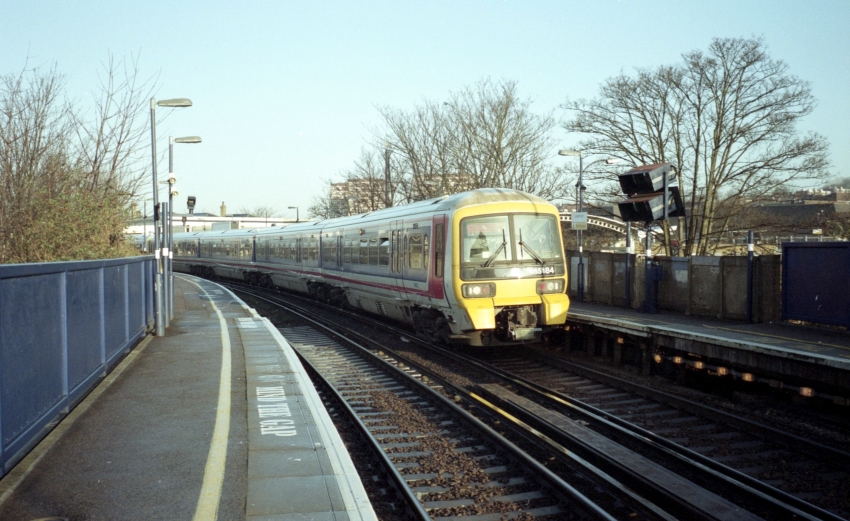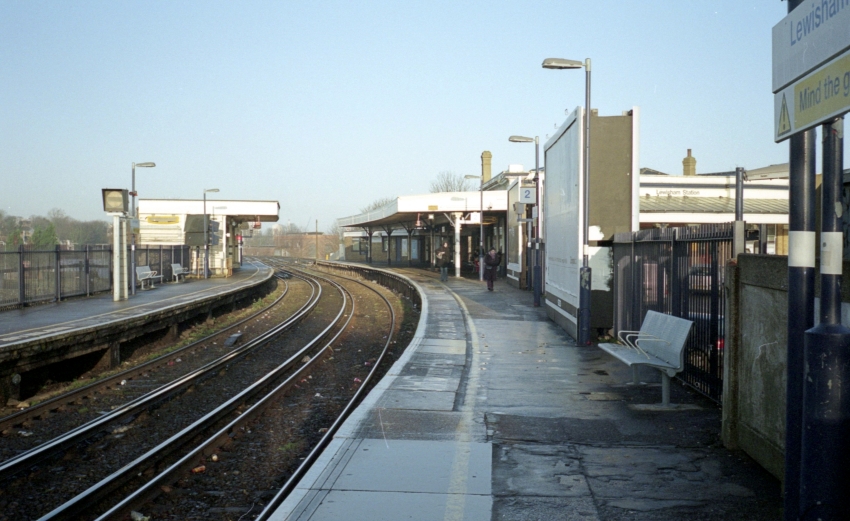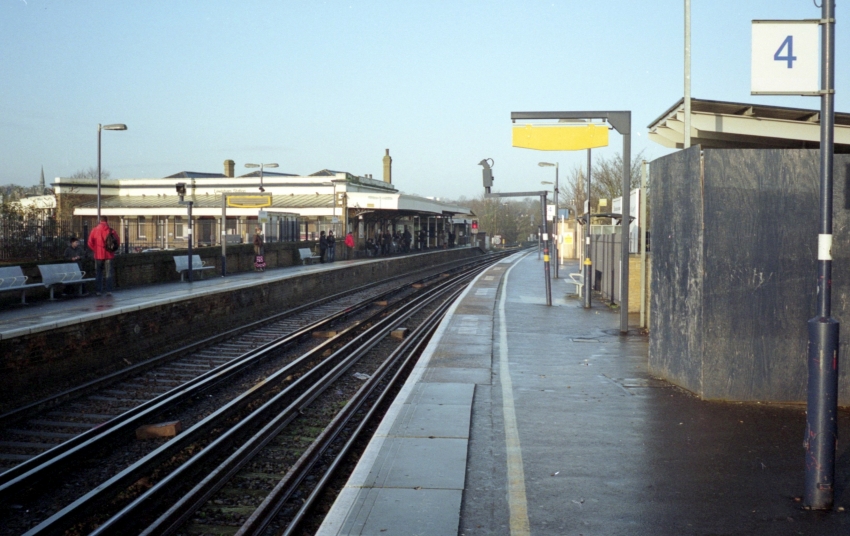Lewisham
Your author estimates 1950 as being the year in which plain timber valances were fitted to those canopies upon platform Nos. 3 and 4, serving the original North Kent Line. Around the same time, concrete bracket lampposts with hexagonal lampshades were installed at the station. This was followed in 1954 by the extension of all four platforms with prefabricated concrete to accommodate longer surburban train formations as part of the ten-car train scheme, in an attempt to alleviate overcrowding on peak-time services. Platform Nos. 1 and 2, serving the Mid-Kent Line, were extended southwards over Loampit Vale road; platform Nos. 3 and 4 were extended eastwards towards Lewisham Road.
At about 6.20 p.m. on 4th December 1957 occurred the dreadful St Johns accident when, in thick fog after dark, the 4.56 p.m. Cannon Street to Ramsgate via Folkestone express, hauled by Unrebuilt Bulleid Light Pacific No. 34066 "Spitfire", collided with the rear of the 5.18 p.m. Charing Cross to Hayes electric service. The latter, ten carriages in length, was stopped at a red signal on the “down” through line, the last vehicle being immediately east of the flyover. When the Ramsgate express passed a red signal and collided with the rear of the electric service, the tender and first carriage of the former were crush together, then swung out and struck one of the flyover’s supporting columns; this caused the southern side of the structure to collapse onto two of the Ramsgate service's coaches. Main line services were diverted to Victoria via Petts Wood and Bickley Junctions; termini at Charing Cross and Cannon Street were initially cut-off from lines converging on Lewisham, but were still accessible via Greenwich. The official accident report notes that an emergency railway service commenced via Lewisham at 6.10 a.m. the morning after the accident, this using the double-track linking Lewisham and St Johns stations. Normal services were resumed over the main line tracks on 12th December 1958, but so damaged was the flyover of the Nunhead line that this route was out of action for a month. Traffic between Nunhead and Lewisham recommenced on 13th January 1958:
New Bridge At Lewisham Fly-Over
The first passenger train to use the Nunhead, South-East London, loop since the St. John's railway disaster five weeks ago, will pass over the new Lewisham fly-over on Monday.
A temporary bridge has been rushed up to replace the fly-over brought down in the crash. [The Londonderry Sentinel, Saturday, 11th January 1958]
From 6th May 1963, Clinker's Register (1980) notes that goods traffic was no longer handled at Lewisham. This must surely be in reference to the earlier-mentioned Granville Park Siding, located east of the North Kent Line platforms, opposite milepost 6¼ from Charing Cross — there were no other sidings evident in the vicinity of the station. A surprising feature of this siding to the very end, if period maps are to be believed, was that of a small wagon turntable, just over halfway down its length.
1970 marked the advent of another re-signalling scheme. From 15th March of that year, four aspect colour aspect lights came into use between Lewisham and Falconwood; the station at the latter had been equipped with lights, rather than semaphores, since it opened in 1936. Control was from a temporary panel at St Johns signal box, prior to major resignalling as part of the rebuilding of London Bridge station. As part of the London Bridge rebuilding scheme, St Johns station was rationalised to a single island platform to vacate space for a single track connection between the flyover and the main line from Hither Green, this coming into use on 29th March 1976. A signalling centre was brought into use on the London Bridge station approaches, which took control of the Lewisham area in 1976; the St Johns to Woolwich Arsenal section of line was transferred to the then new panel on 16th January of that year, followed two days later by the main line from New Cross to Hither Green.
By 1981, large sections had been cut out of the timber canopy valances of platform Nos. 3 and 4, those for the North Kent Line. This could have been in connection with the 1976 resignalling scheme, so sighting of colour lights was not obscured. What of platform 4’s SER timber waiting room, à la that on Bexley’s “up” platform? Tracing the final days of such platform structures is difficult without hard photographic evidence; maps of 1970 show the building still existing, but Ordnance Surveys can often be out-of-date in terms of railway infrastructure. Your author estimates that the structure succumbed in the 1976 to 1980 period.
In 1992 yet more platform extensions works took place, in an effort to accommodate twelve-vehicle “Networker” formations then being proposed. All four platforms were extended at their “country” ends using prefabricated concrete components; Nos. 1 and 2 were extended south to the edge of the River Ravensbourne; Nos. 3 and 4 were lengthened eastwards over and beyond Lewisham Road. Clusters of television screens were also installed at this time in preparation for driver-only operation of commuter services using the then new generation of Class 465/466 electric multiple units. At the time, twelve-vehicle suburban trains were not given clearance to run and it would be over two decades until formations of this length started to operate in passenger service.
On 31st August 1987, the Docklands Light Railway (DLR) opened to scheduled passenger traffic between Tower Gateway and Island Gardens, and the latter and Stratford. In November 1991, a Bill was formally deposited to Parliament for an extension of the DLR from Island Gardens, under the Thames to Lewisham via Greenwich. Royal Assent was received on 27th May 1993, the project initially being budgeted at £200 million. The DLR terminus at Lewisham was to be situated in the fork of the diverging British Rail lines, opposite the existing station forecourt, two covered platforms being located at street level. A series of existing buildings along Junction Road — which formed the ascending approach to the station — required demolition, and the removal of a bus station was also necessary. The double-track standard gauge DLR approached Lewisham from the north west; a concrete tunnel was constructed through the embankment carrying the North Kent Line platforms and under the station's forecourt, to bring the rails to the terminal site. On 29th September 1999, it was announced that the Lewisham DLR extension was to open in the following November, two months ahead of schedule. The first services on the route commenced on 22nd November 1999.
The DLR platforms were covered by a modern curved trainshed, the main part of which measured some 88-foot by 57-foot. To the north of this structure, at roughly the same height as the ex-SER main building, resided a wholly new integrated ticket office, serving both National Rail and DLR passengers. Harmonious with the DLR platforms, this itself was protected by a futuristic-looking roof, measuring some 80 foot by 65 foot. Despite the transferring of ticketing facilities to the new DLR complex, the original SER booking office was, thankfully, left standing, and remained as a concourse and pedestrian thoroughfare between North Kent and Mid Kent platforms.
27th January 2007

No. 465184, wearing Network SouthEast livery complete with black window frames, trundled into the Mid-Kent platforms forming a morning service to Hayes. To the right of the unit's cab can be seen the stack of television screens installed during 1992 as part of the ''Networker'' scheme. These allow the driver to observe down the length of the train when preparing to close the doors. © David Glasspool
27th January 2007

The main station building's façade is evident on the right of this London-bound view of the Mid-Kent Line platforms. A notable feature which still exists is the large timber-backed waiting shelter on the ''up'' side. The fact that the station is elevated above ground level necessitated this structure to have its own dedicated tall brick base, which extends back beyond the rear of the platforms. © David Glasspool
27th January 2007

Another London-bound view this time reveals the North Kent Line platforms and building work taking place on the ''down'' (right) platform. The ''up'' side canopy reveals its now plain valance. © David Glasspool
Return to the Kent Rail Homepage or alternatively, check for Updates.
Website & Copyright information - Links - Contact the Webmaster
